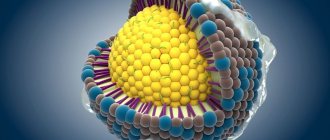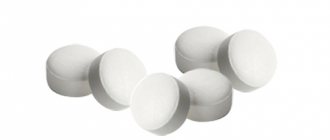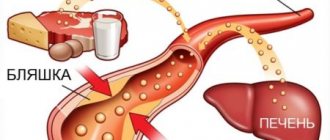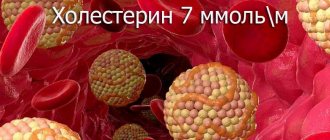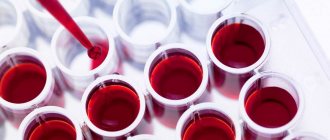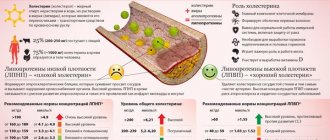LDL (LDL) - what is it in a biochemical blood test?
LDL / LDL (or Low-Density Lipoproteins) are microparticles / protein complexes in the blood plasma (sizes from 18 to 26 nm), the main task of which is to “transport” cholesterol, triglycerides and phospholipids from the liver to peripheral tissues. Initially, they are formed from VLDL / Very Low Density Lipoproteins (during the process of lipolysis / “breakdown”), and then they are transported throughout the body - many vital / important substances. Including cholesterol, triacylglycerides (“energy source” for humans), vitamin E and others.
LDL structure: apolipoprotein B100 (98%), proteins (21-25%), phospholipids (22-24%), triglycerides (10-12%), cholesterol (35-45%)
Another very important “mission” of LDL (as recently proven by Danish/German scientists) is the “neutralization” of poisons secreted by – deadly/life-threatening – bacterial toxins. For example, even those contained in snake or spider venom.
However, despite the many useful features, there is also a downside to the coin. In fact, being a fatty (and therefore “sticky”) alcohol, LDL cholesterol (i.e. cholesterol in low-density lipoproteins) first “sticks” to the walls of blood vessels and then penetrates inside. After which (as a result of other, in fact, defensive reactions), it gradually “gets stronger,” layers, and forms “slides,” which are commonly called “cholesterol plaques.” (See VIDEO AT BOTTOM OF PAGE - 43 sec
). It's better to see once than to hear (or read) 100 times!
That is why LDL cholesterol is considered “BAD” and “harmful”. Unlike HDL cholesterol (high density lipoprotein)
, which scientists call “GOOD” cholesterol. Because its main task (initially, being an “empty taxi”, as American doctors put it) is to “pick up” excesses of the former (i.e. LDL cholesterol) in the blood and “take” it “home” - back to the liver (for processing or - disposal).
Formula for calculating LDL cholesterol levels
In most clinical laboratories, the level of LDL cholesterol (or more precisely, the amount of low-density lipoprotein cholesterol) is determined by a calculation method. At the same time, experts use the Friedwald formula, substituting into it the indicators of the “standard” LIPIDOGRAM
.
That is, TC (Total Cholesterol), HDL cholesterol (the amount of high-density lipoprotein cholesterol) and TG ( TRIGLYCERIDE level)
.
As for the last indicator (that is, TG), it is necessary for laboratory staff (specifically, in this case) to calculate the amount of VLDL cholesterol.
So, Friedwald’s formula/equation (by the way, developed back in 1972) looks like this:
By the way, you can use the ONLINE CALCULATOR
on our website!
- LDL cholesterol (mg/dl) = TC (mg/dl) – HDL cholesterol (mg/dl) – VLDL cholesterol (mg/dl) *
- LDL cholesterol (mmol/l) = TC (mmol/l) – HDL cholesterol (mmol/l) – VLDL cholesterol (mmol/l) **
Where the amount of VLDL cholesterol is calculated by dividing the triglyceride value (TG) by 5 or 2.2 (depending on the unit of measurement):
- * VLDL cholesterol (mg/dl) = TG (Triglycerides): 5
- ** VLDL cholesterol (mmol/l) = (Triglycerides): 2.2
IMPORTANT NOTE:
This calculation method is NOT (!) used if the level (TG) of triglycerides is more than 4.5 mmol/l (or 400 mg/dl).
Subfractional blood test (LDL-P / LLP-C)
It is definitely worth noting that in modern medicine there is another blood test that concerns strictly low-density lipoproteins (i.e. LDL). Its formal name is “subfractional lipid profile.” In principle, in itself, it is the “classical” blood test for LDL cholesterol (as part of the “standard” lipid profile) that can indicate the risks of developing CVD (cardiovascular diseases) quite well. However, according to the results of recent studies, scientists have found that some patients still have a high risk of CVD, even with NORMAL LDL cholesterol levels!
Likewise, people with other chronic diseases (such as type 2 diabetes) can also have healthy LDL cholesterol levels. Thus, in the future, it was decided for certain cases to take into account - NOT (!) the concentration of cholesterol within the LDL fraction, but the number and size of LDL microparticles/compounds (sdLDL). Which, circulating through the circulatory system, can change their shape: from fluffy and large to small and dense. At the same time, the latter, to a greater extent, are the main “culprits” for the development of atherosclerosis.
The official name (in foreign countries) of this blood test/test is: “Low-Density Lipoprotein Subfraction Profile”.
Preparation for analysis and carrying out
To determine cholesterol levels, blood is taken from a vein. You can take the test at any clinic or laboratory; it is usually carried out either free of charge (if at your place of residence) or inexpensive. In order for the results to be reliable, you need to prepare for donating blood:
- The test is taken on an empty stomach - you cannot eat for 10-12 hours;
- dinner on the eve of blood donation should be light; heavy food can distort the result;
- within a few days, it is recommended to completely eliminate fatty foods from the diet;
- in the morning before going to the clinic, you can only drink clean water, but in small quantities;
- You should not smoke several hours before the test, preferably in the evening;
- It is necessary to exclude heavy physical activity; it is better to cancel sports the day before going to the clinic.
This general reminder applies to almost all types of blood tests.
Blood is taken with a syringe from a vein. Usually a 5 cc syringe is sufficient. Results can be ready either within a few hours or the next day. If problems arise as prescribed by the doctor, you can retake the test at least the next day.
When is a blood test (study) prescribed?
A biochemical blood test for LDL cholesterol, being part of a “regular” lipid profile, is primarily prescribed to adequately assess the risks of developing atherosclerotic CVD (i.e., cardiovascular disease). Since, in comparison with all other fractions of cholesterol, it is LDL cholesterol, being in excess, that is considered “undesirable” (or “bad”). Since its “excess”, (gradually) accumulating in the walls of blood vessels, forms “atherosclerotic plaques”
. These formations, somewhat similar to “growing mountains,” not only interfere with normal blood flow, but can also clog blood vessels. And this is fraught with a heart attack, gangrene of the limbs or a stroke.
Next, the doctor decides on the best method of treatment (depending on the borderline
or
a high
amount of LDL cholesterol in the blood plasma, as well as the presence of
other risk factors - they are described just BELOW
).
And, accordingly, controls its effectiveness. The most effective treatment options are some lifestyle changes (giving up bad habits, special diets and exercise therapy/physical therapy). As well as taking lipid-lowering drugs (ATC code C10), for example, STATINS
.
When prescribing the latter, treating specialists will be sure to monitor their effectiveness using a repeat blood test (LDL cholesterol) after 4-12 weeks
(from the start of drug therapy), and then
every 3-12 months
.
MAIN RISK FACTORS
development of CVD (except for high levels of LDL cholesterol):
- smoking (especially “red” tobacco products with a high content of nicotine and tar);
- overweight (with a BMI of 25 and above, according to WHO) or obesity (with a BMI of 30 and more), find out your BMI using the ONLINE CALCULATOR
; - “unhealthy” diet (with an excess of trans fats, animal fats and other foods that increase “bad” cholesterol
); - inactive / “sedentary” lifestyle or physical inactivity (“sedentary work” or other restrictions on physical activity);
- the age of the person (men – from 45 years and older, women – from 55 years and more);
- hypertension/arterial hypertension (high blood pressure syndrome ≥ 140/90 mmHg);
- family history of premature CVD (in 1st degree relatives, i.e. in fathers - up to 55 years old and mothers - up to 65 years old);
- Previous experiences – heart attack or ischemic heart disease (coronary heart disease);
- Type 2 diabetes or pre/diabetes.
NOTE:
HDL cholesterol levels - from 1.55 mmol/l (60 mg/dl) and above, according to the provisions of NCEP (2002), are considered a “negative risk factor”, which makes it possible to exclude from the total one of the above/listed risk factors .
Preventive blood tests for adult men and women
In many foreign countries, a biochemical blood test for LDL cholesterol levels (LDL-C) may be prescribed (as part of a lipid profile) during a mandatory/regular medical examination. According to NCEP recommendations (ATP III), all adult men and women without CVD risk factors (listed ABOVE) should undergo such tests every 4-6 years
.
At the same time, for people who do have 1 or more major risk factors, a blood lipid profile (fasting) can be prescribed MORE FREQUENTLY (at the discretion of the “family doctor”). In addition, it is always prescribed (by the way, both here and in foreign countries) when a general blood test (finger prick) shows elevated cholesterol (C). That is, doctors need it in order to check: is the level of total cholesterol (i.e. Total Cholesterol) high - precisely because of the increased amount of LDL cholesterol?
Blood test for LDL cholesterol for preventive purposes for adolescents and children
For example, in the USA and Canada, according to the recommendations of the AAP (American Academy of Pediatrics), children undergo a lipid profile at 9-11 years of age
(i.e. during the transition to adolescence).
And one more time, as boys and girls, from 17 to 21 years
.
Of course, earlier (and more frequent) comprehensive studies of the blood lipid spectrum can be prescribed - both for children and adolescents who have an increased risk of developing CVD. At the same time, they are exactly the same as in adults. Statistics have shown that the most common problems (from this list) are premature cardiovascular diseases in their parents (fathers and mothers), as well as diabetes, hypertension and obesity. In addition, even very young children with increased risks of CVD should also undergo a lipid profile between the ages of 2 and 8 years
. A child under 2 years old is still too young for such an analysis.
Who is the test prescribed for?
A biochemical blood test for LDL should be regularly carried out for the following categories of people:
- Diabetics;
- Those who have high cholesterol;
- With blood pressure above 140/90;
- Obese;
- With various myocardial diseases;
- With lipid metabolism disorders.
People over 20 should undergo such examination once every 5 years to determine their risk of atherosclerosis. If a person has suffered a stroke, ischemia, or aneurysm, he should also be examined regularly.
Anyone who has started treatment should visit a doctor once a month to monitor the condition.
Abnormalities can only be detected in a biochemical blood test
How to properly prepare for a lipid profile
As a rule, a biochemical analysis of the blood lipid profile (spectrum) is taken on an empty stomach. However, according to the doctor’s decision (especially for young people / without the atherogenic risk factors for CVD listed above), this analysis can be performed without a “hunger strike”. That is, without preliminary/complete refusal of food 9-12 hours before donating venous blood. You can only drink plain water (not sweet/carbonated). Immediately before the lipid profile (30-40 minutes), it is not recommended to: SMOKE and over/exert yourself (both physically and emotionally). In most laboratories, before drawing blood (from a vein), the person is allowed to sit in silence and complete calm for at least 5 minutes.
What could negatively affect the results?
Undesirable distortions in the results of a blood test for LDL cholesterol (or low-density lipoprotein cholesterol) can occur for the following reasons:
- incorrect body position (during collection of venous blood, usually by inexperienced laboratory staff);
- donating blood immediately after an exacerbation of any disease, heart attack, surgery (to obtain true results, you must wait another 6 weeks);
- “stormy” holidays the day before (saturated with alcohol and fatty foods);
- serious stressful situations (divorce, accidents, accidents and even dental visits);
- intense physical activity (related to either heavy physical labor or preparation for sports competitions);
- taking medications, oral contraceptives or “sports” steroids (read: what medications increase plasma cholesterol levels?
); - pregnancy (lipidogram / or blood lipid profile is always prescribed at least 6 weeks after the birth of the child).
Thus, if you find something that is listed above, then immediately notify your doctor, who will prescribe a retake of the blood test in 1-3 months. It is certainly worth noting that the above/listed list is compiled according to statistics (of cases) - both foreign and domestic laboratories.
More about LDL and HDL
The function of LDL (ldl) (called “bad” lipid composition) is to take cholesterol from the liver, which creates it, and transport it through the arteries. There the lipid is deposited in plaques on the walls. This is where the “good” lipid component of HDL comes into play. It takes cholesterol from the walls of the arteries and carries it throughout the body. But sometimes this LDL undergoes oxidation.
The body reacts - the production of antibodies that react to oxidized LDL. HDL cholesterol works to prevent LDL oxidation, it removes excess cholesterol from the walls and returns it back to the liver. But the body secretes so many antibodies that inflammatory processes begin and HDL can no longer cope with its work. As a result, the lining of the arteries is damaged.
Cholesterol control
To do this, a blood test for chol (lipid profile) is done. A blood test is taken from a vein early in the morning. The analysis requires preparation:
- you cannot eat food for 12 hours before donation;
- for two weeks do not eat too fatty foods;
- refrain from physical activity for about a week;
- half an hour before the test, forget about cigarettes and don’t smoke.
Analysis of cholesterol levels in the blood is carried out using rather labor-intensive methods of photometry and sedimentation. These methods are the most accurate and sensitive. A lipidogram is an analysis of the following lipoproteins in the blood:
- Total cholesterol;
- HDL cholesterol (or alpha cholesterol) – it reduces the possibility of atherosclerosis;
- LDL cholesterol (or beta cholesterol) – if it is elevated, the risk of disease increases;
- Triglycerides (TG) are transport forms of fats. If their norm is exceeded, in high concentrations, this is a signal about the onset of the disease.
In addition to atherosclerosis, high cholesterol can provoke a number of other diseases associated with the heart and musculoskeletal tissue.
Decoding LDL cholesterol indicators
What do the results of a lipid profile (relative to the level of LDL cholesterol in the blood plasma) mean - are they good or bad? What do our doctors use to make their final decision? At the moment, both foreign doctors and domestic specialists use the “old” provisions of the NCEP (National Cholesterol Research Program) commission from 2002 to assess lipid levels (and prescribe treatment). Even despite the newer recommendations of the AAC (American College of Cardiology) and AHA (American Heart Association) from 2013. Which specific people should receive cholesterol-lowering therapies (particularly medications) based on age, CVD, diabetes, gender, race, blood pressure, and elevated LDL-cholesterol (LDL-C).
However, this does not mean that everything is outdated, it’s just that Americans are very careful! Therefore, due to the fact that many of the principles of the new guidance remained controversial, it was decided to return to the NCEP recommendations (ATP III). Until pundits fully understand many things, including the ASCVD (Atherosclerotic Cardiovascular Disease) calculator, used to estimate the “10-year risk of developing atherosclerotic CVD. On the results of which, in fact, the fresh recommendations were based. Although, they still began to do some things in a new way. That is, if previously clinics took into account the “target values” of LDL cholesterol (LDL-C) to reduce the risks of atherosclerotic CVD, then since 2013, many experts rely on their percentage reduction. According to recommendations from the AAC and AHA.
LDL cholesterol levels for adults
So, according to the provisions of NCEP (ATP III) for adult men and women (without CVD risk factors), LDL cholesterol levels are estimated as follows:
- less than 100 mg/dl (2.59 mmol/l) – optimal level;
- 100-129 mg/dl (2.59-3.34 mmol/l) – normal / close to optimal;
- 130-159 mg/dl (3.37-4.12 mmol/l) – elevated / borderline values
- 160-189 mg/dl (4.15-4.90 mmol/l) – elevated/high values;
- more than 189 mg/dL (4.90 mmol/L) is a very high (dangerous) level.
More detailed information about the norms of LDL cholesterol (separately for women and men) depending on AGE is presented BELOW - in separate tables.
You may be interested in: cholesterol standards (IN THE TABLE) IN ALL its fractions
LDL cholesterol indicators for children, adolescents and young people
According to the AAP (American Academy of Pediatrics), LDL cholesterol levels for children and adolescents (without CVD risk factors) aged 2 to 17 years are estimated as follows:
- less than 110 mg/dL (2.85 mmol/L) is an acceptable level;
- 110-129 mg/dl (2.85-3.34 mmol/l) – elevated/borderline values;
- more than 130 mg/dl (3.36 mmol/l) – high level.
Also read (link): CHOLESTEROL IS INCREASED IN A CHILD, WHAT SHOULD BE DONE?
Doctors consider LDL cholesterol indicators for young people (i.e. for boys and girls aged 17 to 21 years) as follows:
- less than 120 mg/dL (3.10 mmol/L) – acceptable level;
- 120-159 mg/dl (3.10-4.11 mmol/l) – elevated/borderline values;
- more than 160 mg/dl (4.12 mmol/l) – high level.
Reasons for the increase
The main role is played by a person’s way of life and his diet. Other pathologies in the body also lead to an increase in lipoproteins.
But the main factors are:
- Excess weight. Very often, lipids increase due to the constant consumption of high-calorie foods. Decoding HDL tests also shows this;
- Heredity. The level of lipoproteins increases due to hereditary factors that are transmitted from parents. If relatives have already suffered from such a pathology, then the person is at risk and should constantly study LDL levels;
- Pathologies of blood vessels and myocardium;
- Impaired kidney function;
- Malfunctions of the endocrine system;
- Anorexia;
- Diabetes;
- Disturbance of fat metabolism at the genetic level;
- Malignant formation in the pancreas or prostate gland;
- Smoking and drinking alcohol;
- Restructuring of the body during pregnancy, when hormonal levels are disrupted;
- Sedentary lifestyle.
Those who have such factors are recommended to regularly take a biochemical blood test to determine high or low cholesterol levels. When the indicator is higher than normal, or the LP is lower, urgent measures must be taken.
| Indicator (in mmol/l) | 1.55-2.59 | 2.59-3.34 | 3.37-4.12 | 4.14-4.9 | Above 4.9 |
| LDL level | Normal | Elevated normal | Borderline high | High | Very tall |
When the indicator is higher than normal, or the LP is lower, urgent measures must be taken.
LDL cholesterol (LDL-C) - norm in women table (by age)
Below (in the table) the norms of LDL-C / LDL cholesterol (low-density lipoprotein cholesterol) in blood plasma in girls, young women and adult women are presented by age.
| Age (girls/girls/women): | Norm LDL cholesterol (mmol/l) | LDL-C norm (mg/dL) |
| children from 5 to 10 years old | 1.76 – 3.63 | 68.1 – 140.4 |
| 10 – 15 | 1.76 – 3.52 | 68.1 – 136.1 |
| 15 – 20 | 1.53 – 3.55 | 59.2 – 137.3 |
| 20 – 25 | 1.48 – 4.12 | 57.2 – 159.3 |
| 25 – 30 | 1.84 – 4.25 | 71.1 – 164.3 |
| 30 – 35 | 1.81 – 4.04 | 70.0 – 156.2 |
| 35 – 40 | 1.94 – 4.45 | 75.0 – 172.1 |
| 40 – 45 | 1.92 – 4.51 | 74.2 – 174.4 |
| 45 – 50 | 2.05 – 4.82 | 79.3 – 186.4 |
| 50 – 55 | 2.28 – 5.21 | 88.2 – 201.4 |
| 55 – 60 | 2.31 – 5.44 | 89.3 – 210.3 |
| 60 – 65 | 2.59 – 5.80 | 100.1 – 224.3 |
| 65 – 70 | 2.38 – 5.72 | 92.0 – 221.2 |
| over 70 years old | 2.49 – 5.34 | 96.3 – 206.5 |
Also read (link): about CHANGES IN CHOLESTEROL NORMAL IN WOMEN ACCORDING TO AGE
Low density lipoproteins: normal
Until a certain point, it was believed that the lower the level of low-density lipoproteins, the better. But in the course of numerous studies it has been proven that if the LDL level is low, this may also indicate pathological processes occurring in the body. Therefore, a certain range of values was established - the norm of low-density lipoproteins in the blood, which characterizes normal lipid metabolism in the body and indicates a low risk of developing cardiovascular pathologies.
It is worth noting that the LDL level in women and men is slightly different. This is largely due to differences in hormonal levels, which affect metabolic processes in the body.
The patient’s age, the presence of certain diseases in his medical history (mainly pathologies of the heart or blood vessels), weight, taking certain medications and some other features are also taken into account, which are discussed with the attending physician individually.
The following table shows the norm of “bad” cholesterol, i.e. LDL, for women of different age categories:
| Age | Under 19 years old | 20-29 | 30-39 | 40-49 | 50-59 | 60-69 | 70 years and older |
| LDL norm for women (in mmol/l) | 1,55-3,89 | 1,55-4,14 | 1,81-4,4 | 2,07-4,92 | 2,33-5,7 | 2,59-6,09 | 2,46-5,57 |
For men, the norm for low-density lipoproteins is in the following range (taking into account age):
| Age | Under 19 years old | 20-29 | 30-39 | 40-49 | 50-59 | 60-69 | 70 years and older |
| LDL norm for men (in mmol/l) | 1,55-3,63 | 1,55-4,53 | 2,07-4,92 | 2,33-5,31 | 2,33-5,31 | 2,33-5,57 | 2,33-4,92 |
With age, the production of cholesterol by the liver increases, which is associated with hormonal changes that occur in the body of men and women after 40 years. Therefore, the critical level of LDL shifts upward. But after 70 years, metabolic processes are no longer subject to the same influence of hormones, so the level of “bad” cholesterol becomes the same as in young people.
If a patient is diagnosed with problems with the heart, blood vessels, or the functioning of the pancreas, he has a risk of CVD, or a high level of cholesterol in the blood is detected, then he needs to strive for a lower limit of normal LDL - less than 3 mmol/l. The same recommendation also applies to those patients who have already developed coronary heart disease due to high cholesterol in the blood. Such patients should register with a cardiologist and regularly monitor their blood cholesterol levels.
LDL cholesterol (LDL-C) - norm in men table (by age)
Below (in the table) the norms of LDL-C / LDL cholesterol (low-density lipoprotein cholesterol) in blood serum in boys, young men and adult men are presented by age.
| Age (boy/youth/men): | Norm LDL cholesterol (mmol/l) | LDL-C norm (mg/dL) |
| children from 5 to 10 years old | 1.63 – 3.34 | 63.0 – 129.0 |
| 10 – 15 | 1.66 – 3.34 | 64.1 – 129.0 |
| 15 – 20 | 1.61 – 3.37 | 62.3 – 130.3 |
| 20 – 25 | 1.71 – 3.81 | 66.1 – 147.3 |
| 25 – 30 | 1.81 – 4.27 | 70.0 – 165.1 |
| 30 – 35 | 2.02 – 4.79 | 78.1 – 185.2 |
| 35 – 40 | 1.94 – 4.45 | 75.0 – 172.0 |
| 40 – 45 | 2.25 – 4.82 | 87.0 – 186.4 |
| 45 – 50 | 2.51 – 5.23 | 97.0 – 202.2 |
| 50 – 55 | 2.31 – 5.10 | 89.3 – 197.2 |
| 55 – 60 | 2.28 – 5.26 | 88.2 – 203.4 |
| 60 – 65 | 2.15 – 5.44 | 83.1 – 210.3 |
| 65 – 70 | 2.49 – 5.34 | 96.3 – 206.5 |
| over 70 years old | 2.49 – 5.34 | 96.3 – 206.5 |
(Follow the link) in more detail about AGE CHANGES IN CHOLESTEROL NORMAL IN MEN
LDL cholesterol is elevated – what does this mean?
First of all, high levels of LDL cholesterol, especially in combination with a reduced content of HDL cholesterol (arterial hypertension, obesity, diabetes mellitus and other negative factors), mean an increased risk of developing atherosclerotic diseases of the blood vessels/arteries. Penetrating into the walls of blood vessels, micro/particles of LDL cholesterol form “growing hills”, which are commonly called “cholesterol plaques”. That is, a person begins to develop VASCULAR ATHEROSCLEROSIS
(perhaps even from the age of 20). Over time, the “slides” become higher and can completely block the lumen in the vessels. And this is dangerous in the following ways:
- if the blood vessels of the brain are blocked (for example, as a result of the development of cerebral atherosclerosis), then a STROKE occurs;
- if the main artery of the heart is blocked (due to the development of atherosclerosis of the aorta of the heart), then MYOCARDIAL INFARCTION occurs;
- if obliteration (i.e. blocking) of the walls of the arteries of the legs occurs (due to the development of obliterating atherosclerosis of the lower extremities), then this is fraught with GANGRENE.
However, there are other (no less serious) reasons for increased LDL cholesterol levels (in the blood of WOMEN
and
MEN
). As a rule, they can clearly indicate the development of other dangerous diseases (except for the above/described - atherosclerosis).
- IHD/coronary heart disease (especially in the presence of arterial hypertension, obesity or diabetes mellitus);
- chronic inflammation of the kidneys (advanced to the stage of nephrotic syndrome, which is accompanied, along with other signs, by hyperlipidemia, that is, an increase in the level of total cholesterol - above 6.5 mmol/l);
- cholestasis - a decrease or cessation of bile excretion caused by diseases of the liver (most often hepatitis), bile duct or pancreas;
- chronic renal failure (CRF), as a consequence of a number of diseases and dangerous disorders in the body;
- hypothyroidism (a condition caused by decreased thyroid function);
- serious problems with obesity;
- prostate cancer (prostate);
- pancreatic oncology.
How to reduce LDL levels in the blood to normal?
To reduce elevated LDL cholesterol levels, it is critical to go beyond (just) taking “cholesterol pills.”
(of course, STRICTLY (!) as prescribed by the treating specialist), but also follow very important rules! First, radically change your ENTIRE diet and overhaul your lifestyle. After all, you must agree, will there be any benefit from taking special medications if you immediately ate an “egg sandwich” (maybe even a couple) and had no intention of quitting smoking at all!?
Basic recommendations for changing your diet:
- significantly limit the consumption of saturated fats/fried foods and (!) give up trans fats forever;
- significantly increase the amount of plant fiber consumed in your daily menu;
- drink, eat only low-fat dairy products (or with a minimum amount of fat);
- replace animal proteins with vegetable ones (Canadian scientists have found that soy protein (even 25 grams per day) reduces LDL levels by 4-5%, and with a complete replacement of meat/products - up to 20%);
- switch to OMEGA-3 / polyunsaturated fatty acids (they are found in fatty fish or flaxseed oils);
- Replace sweet juices and carbonated drinks with tea (ideally green!) or plain water.
More detailed information based on the recommendations of domestic and foreign treating specialists can be found at the links below:
- A complete list of the best foods that lower cholesterol and cleanse blood vessels
- Recommended diet for effectively reducing “bad” cholesterol in the blood
- How to quickly lower cholesterol at home (before using pills)
We also recommend that you familiarize yourself with the brief TABLE-REMINDER
(about permitted and harmful foods for elevated cholesterol levels in the blood).
And, plus everything, with a table of cholesterol content in food
.
Basic recommendations for lifestyle changes (after consulting a doctor):
- first of all, quit smoking - find another alternative to this dubious “joy of life” or contact psychologists;
- not only lose weight, but also become a calorie expert (read more about this in the article on reducing triglycerides
); - try to move as much as possible (do regular sports, walk more in the fresh air, swim, dance or ride a bike).
And finally, NEVER TREAT YOURSELF by taking the “best” medications, or following any “dubious diets” read from a “tabloid” magazine.
How to lower LDL cholesterol
When LDL levels are elevated and this is not associated with hereditary factors, the first thing it is advisable to do is change your diet and lifestyle. The main goal is to restore metabolism, reduce LDL, and increase good cholesterol. This will help:
- Physical activity. During exercise, the blood is enriched with oxygen. It burns LDL, improves blood circulation, and eases the load on the heart. For those who previously led a sedentary lifestyle, physical activity should be introduced gradually. At first it could be walking or light jogging. Then you can add gymnastics in the morning, cycling, swimming. It is advisable to train every day for 20-30 minutes.
- Proper nutrition. The basis of the diet should be products that improve the functioning of the digestive tract, metabolism, and accelerate the removal of LDL from the body. Animal fats are consumed sparingly. You cannot completely exclude them from your diet. Animal fats and protein provide the body with energy and replenish cholesterol reserves, because 20% of this substance must come from food.
The basis of the menu for high levels of LDL and total cholesterol should be the following products:
- fresh or boiled vegetables, fruits, fresh berries;
- sea fish - especially red fish, containing many omega-3 acids;
- low-fat kefir, milk, natural yogurt with dietary supplements;
- cereals, cereals - it is better to cook porridge from them; it is advisable to use vegetables for side dishes;
- vegetable, olive, flaxseed oil - can be added to salads, taken on an empty stomach in the morning, 1 tbsp. l.;
- juices from vegetables, fruits, smoothies from berries, green, ginger tea, infusions of medicinal herbs, fruit drinks, compotes.
The principle of cooking is simplicity. The products are boiled, baked in the oven without crust, or cooked in a double boiler. Ready-made dishes can be seasoned with a little salt, oil, herbs, nuts, flax seeds, and sesame seeds can be added. Fried, spicy, smoked - excluded. The optimal diet is 5-6 times a day in small portions.
If changes in diet and exercise do not help normalize LDL levels, or when their increase is due to genetic factors, medications are prescribed:
- Statins reduce LDL levels in the blood by inhibiting cholesterol synthesis in the liver. Today it is the main drug in the fight against high cholesterol. It has significant disadvantages - many side effects, temporary effect. When treatment is stopped, the level of total cholesterol returns to its previous values. Therefore, patients with a hereditary form of the disease are forced to take them all their lives.
- Fibrates enhance the production of lipase, reducing the amount of LDL, VLDL, and triglycerides in peripheral tissues. They improve the lipid profile and accelerate the removal of cholesterol from the blood plasma.
- Bile acid sequestrants stimulate the body's production of these acids. This accelerates the elimination of toxins, waste, and LDL through the intestines.
- Nicotinic acid (Niacin) acts on blood vessels, restores them: expands narrowed lumens, improves blood flow, removes small accumulations of low-density lipids from blood vessels.
Prevention of LDL deviations from the norm consists of following the principles of proper nutrition, giving up bad habits, and moderate physical activity.
After 20 years, it is advisable to take a blood test every 5 years to monitor possible problems with lipid metabolism. People in the older age category are recommended to have a lipid profile every 3 years.
What does it mean if LDL cholesterol is low?
In general, decreased levels of LDL cholesterol (i.e., low-density lipoprotein cholesterol) are not clinically significant. Although, there are some reasons why this happens:
- familial (hereditary) hypocholesterolemia (hypocholesterolemia);
- severe liver diseases (in particular cirrhosis);
- oncological diseases (cancer) of the bone marrow;
- chronic alcohol intoxication (stage 2 alcoholism);
- hyperthyroidism (syndrome caused by hyperfunction of the thyroid gland);
- some inflammatory joint diseases;
- pernicious (or B12-deficiency) anemia (“malignant anemia”);
- inflammatory processes (in the body) or infectious diseases;
- COPD (Chronic Obstructive Pulmonary Disease).
VIDEO:
how are cholesterol (atherosclerotic) plaques formed in the walls of blood vessels (43 sec)?
Possible consequences
There are several complications:
- Cardiac ischemia. Disorder of the functioning of cardiac structures and their nutrition.
- Heart attack. Acute disturbance of trophism and cellular respiration in the myocardium.
- Stroke. As a consequence of atherosclerosis.
- Disability and death from complications.
Low-density lipoproteins are important compounds: in normal quantities they transport cholesterol (the building material of the body), but in high concentrations they are extremely dangerous. Because it carries too much fat, which is deposited on the walls of blood vessels. It is absolutely impossible to delay treatment.
